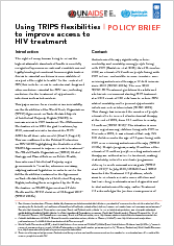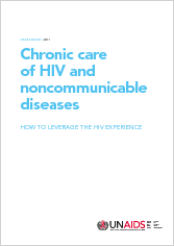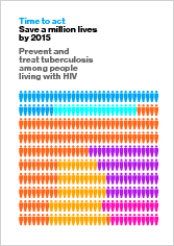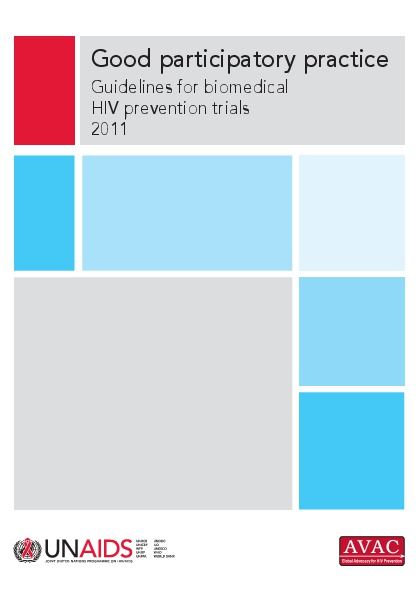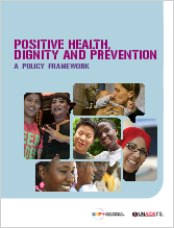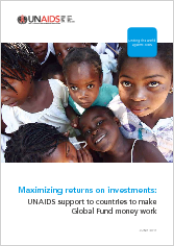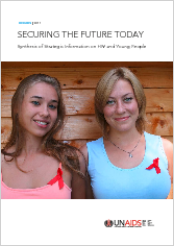Documents
2011 Letter to Partners
18 February 2011
In his 2011 Letter to Partners, Mr Sidibé outlines a set of six new frontiers to move the global AIDS response forward: The democratization of the response; making the law work for not against AIDS; reducing the upward trajectory of programme costs; making funding for AIDS a shared responsibility; making the AIDS movement a bridge to development; and fostering scientific innovation for HIV prevention and treatment.
Documents
Policy Brief - Using TRIPS flexibilities to improve access to HIV treatment
15 March 2011
Documents
Chronic care of HIV and noncommunicable diseases: How to leverage the HIV experience
26 May 2011
Many countries with a high burden of HIV infection also face burgeoning epidemics of noncommunicable diseases. Similar to HIV, noncommunicable diseases are most frequent in low- and middle-income countries, and the age-adjusted death rates from noncommunicable diseases are nearly twice as high in low- and middle-income countries as in high-income countries. People living with HIV often also have high rates of noncommunicable diseases. With HIV programmes rapidly expanding, people with HIV are living longer and ageing, and are developing non-HIV-related chronic conditions similar to the rest of the population.
Documents
AIDS at 30: Nations at the crossroads
02 June 2011
This report provides evidence of how much we have achieved and weighs that against our vision for the future: zero new HIV infections, zero discrimination and zero AIDS‑related deaths. In these pages you will find scientific analysis, personal insights and the results of extensive national and regional consultations at the front lines of the AIDS response. While perspectives differ, one simple truth emerges: we cannot break the arc of this epidemic – where five people were newly infected for every three starting treatment in 2010 – if we adopt a 'business as usual' approach.
Documents
Time to act: Save a million lives by 2015 - Prevent and treat tuberculosis among people living with HIV
06 June 2011
We live in a time of unprecedented hope for the 33.3 million people living with HIV worldwide. Antiretroviral therapy (ART) offers the promise of a full and fulfilling life. Now people living with HIV can raise their families, work and pursue their dreams. But a thief is in our midst—one that is routinely robbing people, and the countries they live in, of their futures. Every minute, three people living with HIV have their lives snatched away by tuberculosis (TB). Africa, hit hard by HIV, is also hit hard by TB. TB is the main cause of death in people living with HIV.
Documents
Good participatory practice: Guidelines for biomedical HIV prevention trials (2011)
29 June 2011
The good participatory practice (GPP) guidelines provide trial funders, sponsors, and implementers with systematic guidance on how to effectively engage with stakeholders in the design and conduct of biomedical HIV prevention trials. In the GPP guidelines, “design and conduct of biomedical HIV prevention trials” refers to activities required for the development, planning, implementation, and conclusion of a trial, including dissemination of trial results.
Documents
Positive Health, Dignity and Prevention – A policy framework
01 July 2011
The primary goals of Positive Health, Dignity and Prevention are to improve the dignity, quality, and length of life of people living with HIV; which, if achieved will, in turn, have a beneficial impact on their partners, families, and communities, including reducing the likelihood of new infections.
Documents
Maximizing returns on investment: UNAIDS support to countries to make Global Fund money work
21 July 2011
This publication describes how the Joint United Nations Programme on HIV/AIDS (UNAIDS) partners with country partners and the Global Fund to Fight AIDS, Tuberculosis and Malaria (Global Fund) to strengthen the global response to AIDS and to accelerate progress towards universal access to HIV prevention, treatment, care and support, and the achievement of the Millennium Development Goals (MDGs).
Documents
Securing the Future Today – Synthesis of Strategic Information on HIV and Young People
27 July 2011
This report shows that these global commitments will be achieved only if the unique needs of young women and men are acknowledged, and their human rights fulfilled, respected, and protected. In order to reduce new HIV infections among young people, achieve the broader equity goals set out in the MDGs, and begin to reverse the overall HIV epidemic, HIV prevention and treatment efforts must be tailored to the specific needs of young people.


